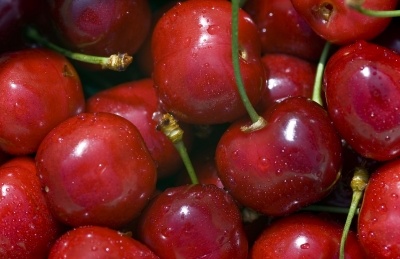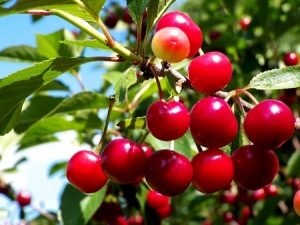
The sweet cherry is a fleshy stoned fruit that is now one of the most popular both commercially and for its culinary-friendliness in the world. It is widely regarded for a host of consumer qualities, especially its vivid, almost translucent orange to dark red skin color, a firm texture with a certain juiciness, a sweetness due to its high sugar content coupled with some sourness, and a pleasing aroma (Diaz-Mula et al., 2009).

For the product developer, the antioxidant content, the total colour content in its juices due to its anthocyanins and the ratio of total solids to total acidity which is dependent on the fruit’s maturity are other key factors nfluencing its popularity (Serrano et al., 2005; Martínez-Romero et al., 2006; Hayaloglu and Demir, 2015).
As well as being ideal as a fresh table fruit, the sweet cherry lends its self very well to product development in the production of toppings for cheesecake such as the Black Forest Gateaux, jams and jellies, fruit syrup, soft drinks, or dried-fruits for bars and cereals.
Cherry Taxonomy
Prunus avium L. is the Sweet Cherry, and Prunus cerasus L. the Sour, Pie, or Tart Cherry. Cherries belong to the Rosaceae family, subfamily Prunoideae. They occupy the Cerasus subgenus within Prunus, being fairly distinct from their stone fruit relatives plums, apricots, peaches, and almonds.
Sweet Cherry Cultivars
It grows in the temperate regions of the world and is rarely found in tropical or sub-tropical regions.
There are nearly 100 different sweet cherry cultivars grown in about 40 major growing and production countries around the world today. Cherry orchards cover 402 thousand hectares around the world.
The best known varieties in the USA are ‘Bing’, ‘Napoleon’ (syn. ‘Royal Ann’), ‘Ranier’, and ‘Lambert’. Pollinizers as it is termed for the main variety are ‘Bing’, ‘Early Burlat’, ‘Black Tartarian’, and ‘Van’. A few other varieties include Belge, Dalbasti, Durona di Cesena, Merton Late, Starks Gold, Summit, Sweetheart, 0-900 Ziraat. The French varieties include Badascony, Burlat, Early Van Compact, Fercer, Fernier, Ferprime, Lala Star, Lapins, Noire de Meched, Sylvia, Vesseaux, Vigred (a red-coloured variety) and Ferrador (bi-coloured)
There are a few self-compatible cultivars such as ‘Stella’ and ‘Lapins’, but they are of poorer quality than ‘Bing’ and others that form the basis of the industry.
Commercial Production
Turkey is the principal producer based on 2012 data and represents 21% of global production at 481 metric Tonnes, then the USA, Iran and Italy in that order (FAO, 2014). The fruit is also of great commercial importance in countries such as Spain and the United Kingdom.

Componentry
The sugar content is mainly sucrose, glucose, fructose and sorbitol and the sum total ranges from 125 to 265 g/kg fresh weight (FW). The organic acids are mainly malic, citric, shikimic and fumaric acids which range from 3.67 to 8.66 g/kg fresh weight (FW).
The main chemical componentry are various phenols such as the anthocyanins, flavan-3-ols, and flavonols in addition to the non-flavonoid compounds such as hydroxycinnamic and hydroxybenzoic acids (Gao and Mazza 1995; Mozetic et al., 2006). The phenolic content ranges from 44.3 to 87.9 mg gallic acid equivalents/100 g FW and an antioxidant activity ranging from 8.0 to 17.2 mg ascorbic acid equivalent antioxidant capacity mg/100 g FW. The antioxidant activity correlates with its total phenolics and anthocyanin content which is also cultivar dependent.
The major anthocyanin pigments in sweet cherries have been identified as cyanidin-3-rutinoside, cyanidin-3-glucoside, peonidin-3-rutinoside, peonidin-3-glucoside, and pelargonidin-3-rutinoside has been identified specifically in Bing and other sweet cherry cultivars (Lynn and Luh 1964; Gao and Mazza 1995; Mozetic et al., 2002).
The health benefits are said to be due to these particular phenolic compounds, its various organic acids and sugars (Kelebek and Selli, 2011).
Much of the aroma is attributed to a simple ester, ethyl acetate followed by other esters such as ethyl butanoate, ethyl hexanoate, 2-methylpropyl hexanoate, and isoamyl acetate. It is apparent that ethyl acetate and ethyl hexanoate contributed to the characteristic aroma of sweet cherry (Zhang et al., 2007). The concentration of these esters rises as the fruit ripens which in turn improves the aroma impact (Serradilla et al., 2011; 2012; Matthias et al., 1997). The changes of ethyl acetate in fruits were linked to the accumulation of ethanol due to storage under anaerobic conditions (Mattheis et al., 1997).
The major volatiles found were 1-hexanol, (E)-2-hexen-1-ol, benzylalcohol, hexenal, (E)-2-hexenal, and benzaldehyde in a set of Turkish varieties were recently quantified (Hayaloglu and Demir, 2016).
The enzyme activities present in the fruit has been extensively examined (Mulabagal et al., 2009). There is also a burgeoning collection of articles assessing the impact of sweet cherry components on fat cells, reduction of low-density lipoproteins and the like (Gonçalves et al., 2004).
You might be interested to know more about the health properties of a related ‘sour’ cousin, the Montmorency cherry whose juice is associated with alleviating muscle soreness (see article) and reducing respiratory issues in marathon runners (see article).
If you are interested in growing sweet cherry as a fruit crop we have a separate article on its cultivation. This is part of a series on growing fruit and vegetables.
References
Diaz-Mula, H.M., Castillo, S., Martinez-Romero, D., Valero, D., Zapata, P.J., Guillen, F., Serrano, M. (2009) Sensory, nutritive and functional properties of sweet cherry as affected by cultivar and ripening stage. Food Sci. Technol. Int. 15(6): pp. 535–43.
FAO. (2014) Food And Agriculture Organization of The United Nations. Available from: http://faostat3.fao.org/faostat-gateway/go/to/download/Q/QC/E. Accessed 26th January 2015.
Gao, L., Mazza, G. (1995) Characterization, quantification and distribution of anthocyanins and colourless phenolics in sweet cherry. J. Agric. Food Chem. 43 pp. 343–346
Girard, B., Kopp, T.G. (1998) Physicochemical characteristics of selected sweet cherry cultivars. J Agric. Food Chem. 46 pp. 471–6.
Gonçalves, B., Landbo, A.K., Let, M.D., Silva, A.P., Pereira, J.M., Rosa, E., Meyer, A.S. (2004) Storage affects the polyphenolic profiles and antioxidant activities of cherries (Prunus avium L.) on human low-density lipoproteins. J. Sci. Food Agric. 84 pp. 1013–20.
Gonçalves, B., Silva, A.P., Moutinho-Pereira, J., Bacelar, E., Rosa, E., Meyer, A.S. (2007). Effect of ripeness and postharvest storage on the evolution of colour and anthocyanins in cherries (Prunus avium L.). Food Chem. 103 pp. 976–84.
Gonzalez-Gomez, D., Lozano. M., Fernandez-Leon, M.F., Bernalte, M.J., Ayuso, M.C., Rodriguez, A.B. (2010). Sweet cherry phytochemicals: Identification and characterization by HPLC-DAD/ESI-MS in six sweet-cherry cultivars grown in Valle del Jerte (Spain). J Food Comp Anal 23 pp. 533–9.
Gundogdu, M., Bilge, U. (2012). Determination of organics, phenolics, sugars and vitamin C contents of some cherry cultivars (Prunus avium). Intl. J. Agric. Biol. 14 pp. 595–99.
Hayaloglu, A.A., Demir, N. (2015) Physicochemical characteristics, antioxidant activity, organic acid and sugar contents of 12 sweet cherry (Prunus avium L.) cultivars grown in Turkey. J. Food Sci. 80 C564–70.
Hayaloglu, A. A., Demir, N. (2016), Phenolic Compounds, Volatiles, and Sensory Characteristics of Twelve Sweet Cherry (Prunus avium L.) Cultivars Grown in Turkey. J. Food Sci. 81: C7–C18. doi: 10.1111/1750-3841.13175
Kelebek, H., Selli, S. (2011) Evaluation of chemical constituents and antioxidant activity of sweet cherry (Prunus avium L.) cultivars. Int. J. Food Sci. Technol. 46 pp. 2530–7
Lynn, D.Y.C., Luh, B.S. (1964) Anthocyanin pigments in Bing cherries. J. Food Sci. 29 pp. 735–43.
Martínez-Romero, D., Alburquerque, N., Valverde, J.M., Guillén, F., Castillo, S., Valero, D., Serrano, M. (2006) Postharvest sweet cherry quality and safety maintenance by Aloe vera treatment: a new edible coating. Postharv. Biol. Technol. 39 pp. 93–100.
Mattheis, J.P., Buchanan, D.A., Fellman, J.K. (1997) Volatile constituents of Bing sweet cherry fruit following controlled atmosphere storage. J. Agric. Food Chem. 45 pp. 212–6.
Mozetic, B., Simcic, M., Trebse, P. (2006) Anthocyanins and hydroxycinnamic acids of Lambert Compact cherries (Prunus avium L.) after cold storage and 1-methylcyclopropene treatment. Food Chem. 97 pp. 302–9.
Mozetic, B., Trebse, P., Hribar, J. (2002) Determination and quantitation of anthocyanins and hydroxycinnamic acids in different cultivars of sweet cherries (Prunus avium L.) from Nova Gorica Region (Slovenia). Food Technol. Biotechnol. 40 pp. 207–12.
Mulabagal, V., Lang, G., Dewitt, D., Dalavoy, S.S., Nair, M.G. (2009). Anthocyanin content, lipid peroxidation and cyclooxygenase enzyme inhibitory activities of sweet and sour cherries. J. Agr. Food Chem. 57 pp. 1239–46.
Serradilla, M.J., Lozano, M., Bernalte, M.J., Ayuso, M.C., Lopez-Corrales, M., Gonzalez-Gomez, D. (2011) Physicochemical and bioactive properties evolution during ripening of ‘Ambrun´es’ sweet cherry cultivar. LWT-Food Sci. Technol. 44 pp. 199–205
Serradilla, M.J., Martin, A., Ruiz-Moyano, S., Hernandez, A., Lopez-Corrales, M., de Guia Cordoba, L.(2012) Physicochemical and sensorial characterization of four sweet cherry cultivars grown in Jerte Valley (Spain). Food Chem. 113 pp. 1551–9.
Serrano, M., Guillen, F., Martinez-Romero, D., Castillo, S., Valero, D. (2005) Chemical constituents and antioxidant activity of sweet cherry at different ripening stages. J. Agric. Food Chem. 53 pp. 2741–5.
Usenik, V., Fabčič, J., & Štampar, F. (2008). Sugars, organic acids, phenolic composition and antioxidant activity of sweet cherry (Prunus avium L.). Food Chem., 107(1), pp. 185-192.
Vursavus,¸ K., Kelebek, H., Selli, S. (2006) A study on some chemical and physicomechanic properties of three sweet cherry varieties (Prunus avium L.) in Turkey. J. Food Eng., 74 pp. 568–75
Zhang, X., Jiang, Y.M., Peng, F.T., He, N.B., Li, Y.J., Zhao, D.C. (2007) Changes of aroma components in Hongdeng sweet cherry during fruit development. Agric. Sci. China 6 pp. 1376–82.
Leave a Reply